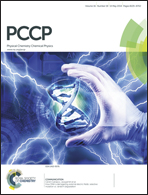Emergence of spin-filter states in Pt–Fe nanowires
Abstract
Our theoretical study predicts the emergence of a new spin-filter state in one-dimensional Pt–Fe bimetallic nanowires. The results show the existence of two transmission states in contracted “zig-zag” Pt–Fe nanowires with low and high transmission 1G0 and 3G0, correspondingly, and one transmission state in linear stretched nanowires with conductance 2G0. Our first principle calculations revealed the dependence of quantum conductance of Pt–Fe nanowires on their geometry and atomic structure. Thus we found that nanowire stretching up to the interatomic distance of 2.3 Å leads to the transition of the wire from a “zig-zag” to the linear configuration, leading to changes in the conductance properties of the wire, i.e. formation of a new spin-filter state. Our study shows also the emergence of a magnetic transition from ferromagnetic to antiferromagnetic states under wire stretching. We found that the spin-filter state exists only in “zig-zag” Pt–Fe nanowires in the ferromagnetic state. Moreover, the spin-polarization of quantum electron transport through Pt–Fe nanowires vanishes totally in linear stretched nanowires in an antiferromagnetic state. Our electronic structure calculation reveals the emergence of new hybridized states in the band structure of the Pt–Fe nanowire, which causes the formation of a new spin-filter state.


 Please wait while we load your content...
Please wait while we load your content...